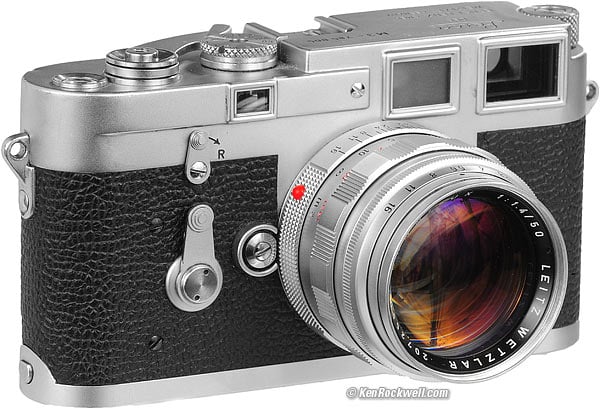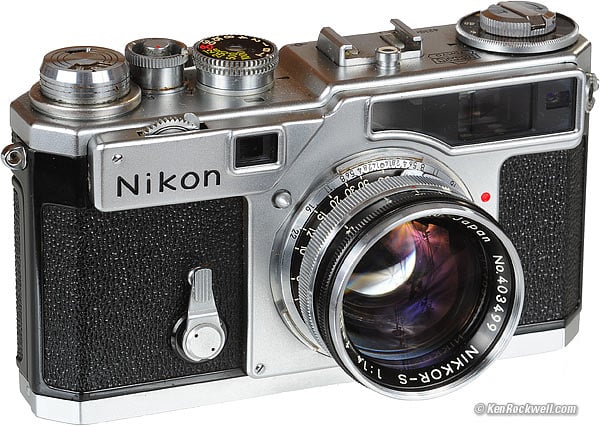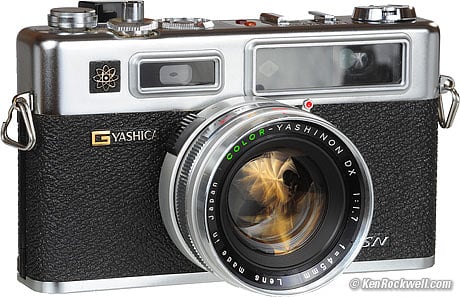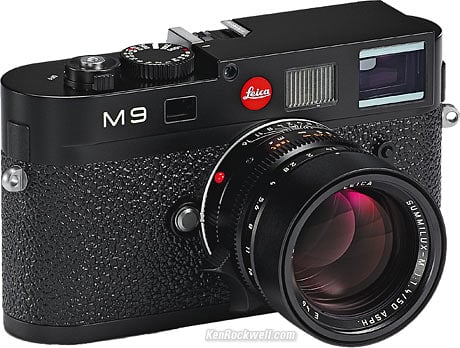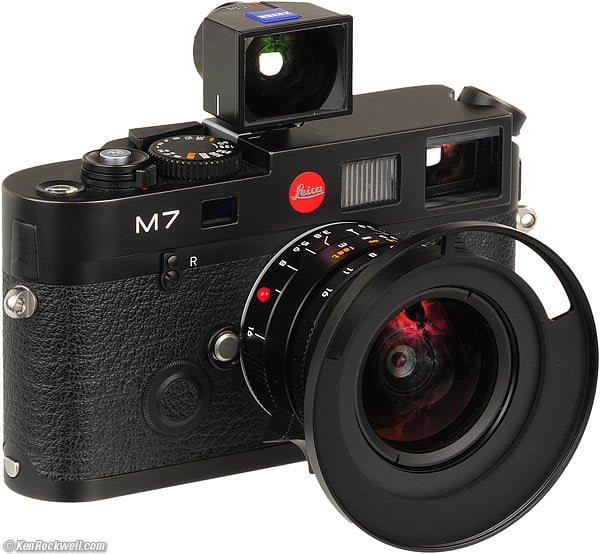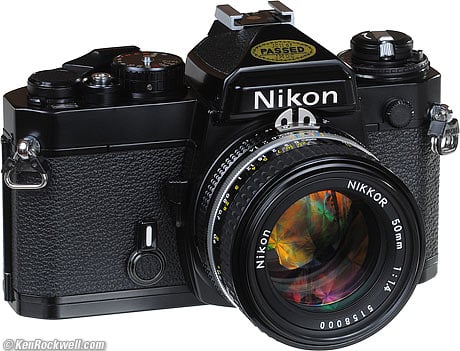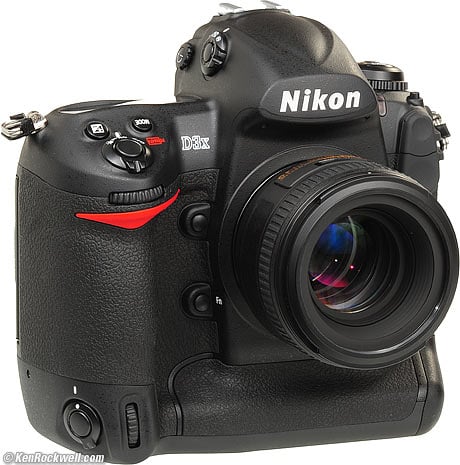Home Donate New Search Gallery Reviews How-To Books Links Workshops About Contact
Rangefinders vs. SLRs
© 2009~2012 KenRockwell.com. All rights reserved.
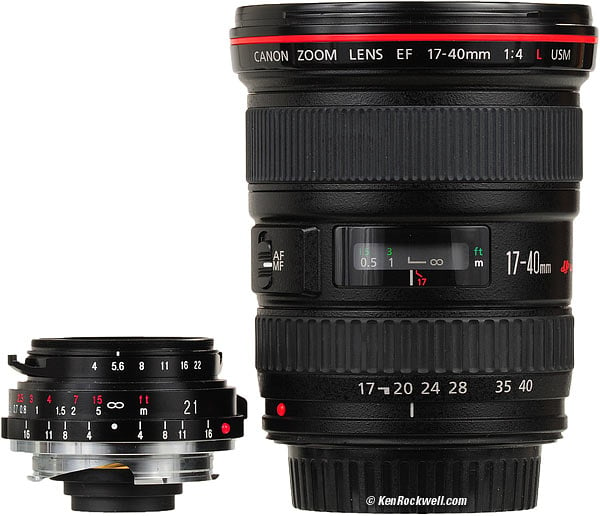
Two 21mm f/4 lenses compared: Voigtländer's 21mm f/4 for rangefinder cameras vs. Canon's "compact" 17-40mm f/4 L for SLRs. enlarge.
This free website's biggest source of support is when you use any of these links when you get anything, regardless of the country in which you live. Thank you! Ken.
December 2012 Better Pictures LEICA Contax Nikon Canon Fuji All
Introduction
SLRs are the most popular cameras today, and have been since the 1960s, yet rangefinder cameras are still around and are smaller, lighter, and give higher quality images.
With all these advantages to rangefinder cameras, why aren't they as popular? Good question.
First I'll explain each camera type, and then the advantages and disadvantages of each.
Each kind of camera comes in both RealRaw and digital, and comes in most formats, 35mm and medium format. I'm only showing 35mm cameras here because I got lazy.
Rangefinder: definition advantages disadvantages
SLR: definition advantages disadvantages
Rangefinders
What's a rangefinder camera? top
Leica M3 (1954-1967).
Nikon SP (1956-1962).
|
Adorama pays top dollar for your used gear. I use these stores. I can't vouch for ads below.
|
Rangefinder cameras were the most popular small cameras of the 1950s.
Leica cameras are the only popular ones still available new today. Leica was always — and still is — a very expensive and very good camera.
Back when rangefinders were popular, you could get them in every quality and price range, for instance, the Yashica Electro 35.
Yashica Electro 35 GSN (1966-1977). bigger.
These are called "rangefinder" cameras because they focus using a dual-image rangefinding device. You turn a ring, and when two superimposed images line up, you're in perfect focus.
With a rangefinder camera, you never look through the lens. You focus and compose through a window on the top right, just like on a disposable camera.
The rangefinder looks out of the little window on the left. It triangulates as you turn the focus ring, bringing two images into correlation at perfect focus.
The middle rectangular window just above and to the right of the lens on most rangefinder cameras collects light to make the frame lines brighter. This is a sign of a good camera; the cheapest rangefinder cameras omit this third window and have wishy-washy framelines instead.
Today's state of the art Leica M7, M9 and the Mamiya 7 are the same as rangefinders of decades past, and work exactly the same way.
Some rangefinder cameras, like the Leicas, Contax, and Mamiya 7, have full lines of interchangeable lenses, while others like the Nikon 35Ti, Yashica, Canonet, Ricoh, Petri and Olympus have fixed lenses.
Advantages of Rangefinder Cameras top
Rangefinder cameras have many advantages over SLRs. Among them are:
Rangefinder cameras have higher image quality
Because there is no flipping mirror, lenses can be designed without having to keep the back of the lens far enough away from the image plane to avoid getting hit by the mirror.
For wide-angle lenses, allowing lens designers to make lenses whose rear elements can come very close to the image plane lets wide-angle rangefinder lenses be much smaller, sharper and have less distortion than SLR lenses.
Because there is no flipping mirror, there is much less vibration to blur hand-held images. At speeds of around 1/30 - 1/8, the flipping mirrors of SLRs often blur shots made from tripods unless a mirror lock-up is used.
Rangefinder cameras have far more precise focusing for wide and normal lenses.
Rangefinder cameras are smaller and lighter
Rangefinders do without the extra weight of prisms, focus screens and flipping reflex mirrors.
Rangefinder lenses are smaller and lighter
As shown at the top, wide and normal rangefinder lenses are often tiny because they don't need to be designed to clear a flipping mirror.
Superior wide-angle lenses
It's easy to get wide, ultra-wide and ultra-ultra wide lenses for rangefinder cameras.
It's trivial to get lenses as wide as 12mm on full-frame, with little to no distortion.
Even the cheapest wide rangefinder lenses, like the Voigtländers, are usually excellent, while the very best wide zoom SLR lenses like Canon's newest 16-35mm f/2.8 L II and Nikon's 17-35mm f/2.8 AF-S are only mediocre by comparison.
Rangefinder cameras are quieter
There are no mirrors flipping up and down for each and every shot. With a rangefinder, all you hear is the quiet click of just the shutter.
Rangefinder camera viewfinders never black-out
As SLR mirrors flip up to take a picture, their viewfinders go black at the most important instant: the instant at which an image is recorded forever. Rangefinder camera viewfinders never black out, so you always know the subject's expression as it's recorded, especially with flash.
When making long exposures, you can see through the viewfinder the whole time.
Focus, Compose and Shoot with Both Eyes Open
If you have a life-size finder, as on the Nikon SP and almost on the Leica M3, you can focus, compose and shoot with both eyes, since the rest of the camera doesn't cover your left eye.
With other cameras, you sometimes can get eyepiece magnifiers, or try it anyway if the finder reduces.
On Leica with the 135mm f/2.8 ELMARIT, the built-in magnifier gives life-size images with the 0.72x cameras, which is most Leicas since 1980.
Rangefinder cameras have no shutter lag
With a rangefinder, press the button, and it goes. You've captured the peak of the moment, forever.
With an SLR, the mirror has to get out of the way before the shutter can open.
By the time the SLR mirror gets out of the way, your decisive moment is gone.
Is there any wonder that the masters, Salgado (Leica), Ansel Adams (Contax) and Cartier-Bresson (Leica) shoot or shot only rangefinder 35mm cameras, not SLRs?
In-the-dark passive focusing
So long as there is enough light to see, you can focus a rangefinder camera immediately and without needing any annoying AF assist lights. Just flip the focus until the two images merge, and voila!, perfect focus.
With my D3, I have to guess and focus manually by trial and error when the light gets too dim. With rangefinder cameras, it's never too dim.
Disadvantages of rangefinder cameras top
You never know what you're getting
With rangefinder cameras, your viewfinder is separate, and sees from a different point of view.
For normal shots at normal distances, this isn't important, but for long lenses or macro use, rangefinders give you no clue to what you're getting.
Even with a LEICA rangefinder, you never really know what you got until you see your final image. You never see any hint of depth of field with a rangefinder, in whose viewfinders everything is always in perfect focus.
With a rangefinder camera and a long lens, you're usually looking at only a small cut-out frame in the finder.
With a wide lens wider than about 24mm, you need to clip-on a separate extra-wide accessory viewfinder into your hot shoe. You focus and set exposure through the main finder, and compose through the separate wide finder.
Leica M7 with 18mm lens and separate 18mm viewfinder. enlarge.
Finder Blockage
If your lens is too big, you may see it in the corner of your finder, which prevents you from seeing all of your image.
When you do use an external finder for an ultrawide lens, often the lens will block some of the image in the finder! Some lenses use cut-outs to try to work around this.
The clever rangefinder photographer avoids big lenses, and prefers lenses small enough not to block his viewfinder.
No stupid lenses
You can get every lens you actually need for rangefinder cameras, but you can't get stupid things craved by newcomers like fisheyes and ultra-telephotos.
Heck, you rarely can get zooms for rangefinder cameras.
With rangefinders, you simply move a few steps forward or back to get perfect composition.
Rangefinders need constant service
The rangefinder mechanism is a delicate mechanical instrument.
Even with the LEICA, it will need to be adjusted for optimum results every so often.
Poor focus with tele lenses
Rangefinder cameras measure the distance with the same hardware, regardless of lens choice. This is a huge advantage for wide lenses, but a severe limitation with long lenses.
Even with the LEICA or Mamiya 6 and 7, only half the samples of lens and camera combinations I've tried with long lenses give perfect focus at large apertures.
Most shooters never notice this as a focus issue and instead blame their lenses, but what many cameras and lens combinations really need is adjustment at a repair shop to get things perfect.
When I get new lenses, I handpick them to be sure that they give me perfect focus with my particular camera. Once chosen, they give great results for a long time, while some individual samples of camera and lens just don't work well together.
Focus only in one spot: the center
Rangefinder cameras can only focus on a spot in the center of the image.
They cannot focus anywhere else in the frame, so you have to focus and then compose. If the subject moves, you're back to square one.
To counter this, experianced rangefinder shooters learn by how much to move the focus lever to compenstate blindly.
No macro or close focus
Rangefinder cameras rarely focus closer than two or three feet (0.6 - 1m).
Even at this distance, the viewfinder is far enough away from the lens that you probably aren't going to get the picture you intended to get.
Yes, you can buy all sorts of crazy macro contraptions for rangefinder cameras, but even if they let you focus closely, you're still not looking through the lens.
SLRs
What's an SLR Camera? top
SLRs are the most popular cameras today.
SLR means single-lens reflex. A DSLR is a Digital SLR.
Reflex means that there is a reflex mirror that bounces light up from the lens onto a flat ground-glass screen.
You see this image through a prism that makes the screen look like it's standing straight-up in front of you.
The prism is what sits inside the lump on top of the lens.
Nikon D3X (2008-). bigger. Its battery alone is bigger and heavier than some rangefinder cameras.
SLRs have many advantages over rangefinders, which is why they replaced rangefinders for most — but not all — people as of the 1960s.
Advantages of SLR Cameras top
So why have SLRs all but replaced rangefinders these past forty-plus years? Why would anyone want to carry a bigger, heavier, noisier camera that gives fuzzier pictures and can't focus well in the dark, that no one can figure out?
Through-the-lens viewing
SLRs see exactly what the lens does.
SLRs see the exact composition, the exact framing, the exact point-of-view, the exact perspective, and usually the exact depth-of-field.
No mater how long or short your lens, or the distance to the subject, what you see is what you get.
Focus anywhere in the frame, any time
Since SLRs have ground-glass or matte focus fields throughput the entire frame, you can see and focus manually anyplace in the frame just by looking at it while you move the focus ring.
No SLR as of this writing (December 2012) has autofocus sensors that cover the entire frame, but you can focus manually anyplace in the frame after you've composed if your subject moves.
Macro
SLRs are great for macro. Even ordinary lenses focus close, and you see exactly what you're going to get through the finder as you compose and focus.
Ultra-telephoto lenses
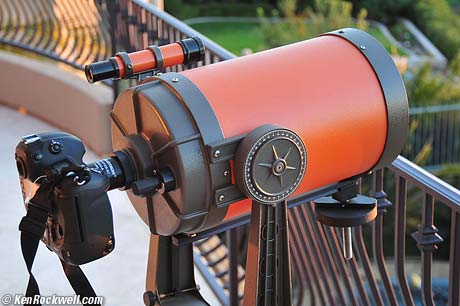
Nikon D3 on a classic Celestron 8.
It's trivial to use any long lens, even a 2,000mm Celestron telescope, with any SLR. Just attach it, and what you see is what you get.
SLRs focus just as well with long lenses as they do with short lenses.
Rangefinder cameras work well with lenses up to 135mm. After that, the only way to use them is with stupid Visoflex and reflex attachments, which turns them into SLRs.
Fisheye lenses
Likewise, SLRs have many fisheye lenses available, while with rangefinders, you have to make do with non-distorting 12mm lenses.
Disadvantages of SLR cameras top
Inferior optics
SLR optics are designed for convenience and autofocusing.
SLR tele and tele zoom lenses can be excellent, but SLR wide-angle lenses have to be designed as retrofocus lenses to avoid hitting their reflex mirrors. This gives wide lenses which are softer, especially in the corners, and much more distorted.
Inferior image quality
The flipping mirror of an SLR can blur both hand-held and tripod-mounted shots.
This is why better SLRs have mirror lockups for use in a tripod.
Shutter lag
With an SLR, the mirror has to get out of the way before the shutter can open.
It may only be an instant, but if that's the instant that you hoped to capture as the decisive moment, it's already gone by the time the shutter opens.
Slow lenses look dim
SLR viewfinders get dim with slow lenses.
With the popularity of slow zooms, SLR finders made since about 1979 are optimized for brighter screens with slow lenses, at the expense of less focus precision with fast lenses and the inability to see the true field with faster lenses.
Poor manual focus accuracy
With fast lenses, SLRs need painstaking adjustment of their mirrors and focus screens to ensure that what you see in the finder matches what you get on film.
SLR microprisms and split-images are optimized for slower lenses, so you don't; get the best accuracy with faster lenses.
Poor autofocus accuracy
Some SLR AF systems, like Canon's, are designed for speed over repeatability or accuracy. Therefore, with some lens and camera combinations, a certain small percentage of your photos won't be in perfect focus. If a camera screws up focus, why use it?
All AF SLRs occasionally suffer from AF offset with some lenses, meaning that they consistently focus too far or too close. That again is just the way electronic AF systems work, and something which is not a problem with properly adjusted rangefinder cameras.
Too big and too heavy
SLRs became dominant back when SLRs weren't that much bigger than rangefinder cameras.
Today, SLRs have grown out of control, another reason the LEICA is eating the SLR market so quickly. Today's LEICA M9 weighs exactly the same as the LEICA M3 of 1954 (587g), while today's Nikon D3 weighs twice as much (1,500g) as Nikon's first fat Nikon F of 1959.
Too many junk settings
Today's SLRs have so many added junk features and settings that no one can figure them out.
By the time you get an SLR turned on and ready to shoot, you've missed the moment while the rangefinder shooter has already gotten his picture.
Poor to no focus in dim light
The SLR is either relatively helpless in low light, or needs an annoying AF assist light to help it out.
It difficult to impossible to see anything to focus manually on an SLR in the dark, while it's easy with a rangefinder.
Too many batteries
Rangefinders run years on a single battery, which often powers only the meter and not the camera.
Modern SLRs are often useless unless you bring batteries and chargers for them.
Differences between rangefinders and SLRs top
SLR viewfinders are an image surrounded by black.
Rangefinder viewfinders are usually a larger image with a smaller frame inside. Your picture is only what's in the frame.
I prefer the image surrounded by black of SLRs, while some others prefer to be able to see things outside the frame with rangefinders. With rangefinders, you can see if anything is about to enter your image before it does.
Recommendations top
SLRs are completely different from rangefinders, just as girls and boys, or trucks and trains, are completely different from each other.
Which is better depends on what you're trying to do. I wouldn't expect my daughter to play for the NFL, and I wouldn't expect my son to breast-feed my future grandkids either. There are some kinds of things at which each kind of camera either excels or just can't do.
SLRs tend to have more automation, at the price of not being able to figure out how to use them. Rangefinders are less automated, and therefore easier to set and use. SLRs offer a crazed range of stupid lenses, while rangefinders offer a better range of the lenses we actually need.
Get a rangefinder for:
Superior image quality, especially with wide-angles.
Significantly less size and less weight, for both cameras and every lens.
Ideal for nature, landscapes and things that hold reasonably still.
Ideal for travel.
Low-cost rangefinders
For serious use, used LEICAs are excellent.
Get an LEICA M3, which is arguably the greatest camera anyone has ever made, and it ought to run you under $1,000.
See Leica Lenses for lens suggestions. Everything they've made since 1954 is 100% compatible!
For low-cost lenses, Leica's lenses from the 1950s are spectacular and available for $69 and up used. Favorites are the 35mm f/2.8, any 50mm f/2, and any 90mm, especially the 90mm TELE-ELMARIT-M, each selling at $400 or less used.
Less of a good buy is to buy new Japanese Voigtländer lenses. The Zeiss lenses cost more, and are excellent.
The recent Contax G System is the most advanced rangefinder camera system ever devised. It even offers autofocus! Several hundred well-spent dollars will get you well set up.
For $10 an Olympus 35 RC or for $5 an Olympus Trip 35 is hard to beat. Beat around thrift stores and garage sales and you ought to find plenty.
Get an SLR for:
Ideal for fast-moving things like kids, sports and action.
Ideal for macro, fisheye and ultra-telephoto lenses.
Ideal for use in the studio.
Low-cost SLRs
Want a great SLR for little money?
Get the Nikon D3200 for digital, or any 1970s-era Nikon 35mm for RealRaw.
If you want autofocus, try the Nikon N65, N75 or F100, which are Nikon's newest RealRaw AF SLRs, and today sell for under $100 used.
Help me help you top
I support my growing family through this website, as crazy as it might seem.
The biggest help is when you use any of these links when you get anything, regardless of the country in which you live. It costs you nothing, and is this site's, and thus my family's, biggest source of support. These places have the best prices and service, which is why I've used them since before this website existed. I recommend them all personally.
If you find this page as helpful as a book you might have had to buy or a workshop you may have had to take, feel free to help me continue helping everyone.
If you've gotten your gear through one of my links or helped otherwise, you're family. It's great people like you who allow me to keep adding to this site full-time. Thanks!
If you haven't helped yet, please do, and consider helping me with a gift of $5.00.
As this page is copyrighted and formally registered, it is unlawful to make copies, especially in the form of printouts for personal use. If you wish to make a printout for personal use, you are granted one-time permission only if you PayPal me $5.00 per printout or part thereof. Thank you!
Thanks for reading!
Mr. & Mrs. Ken Rockwell, Ryan and Katie.
Home Donate New Search Gallery Reviews How-To Books Links Workshops About Contact

